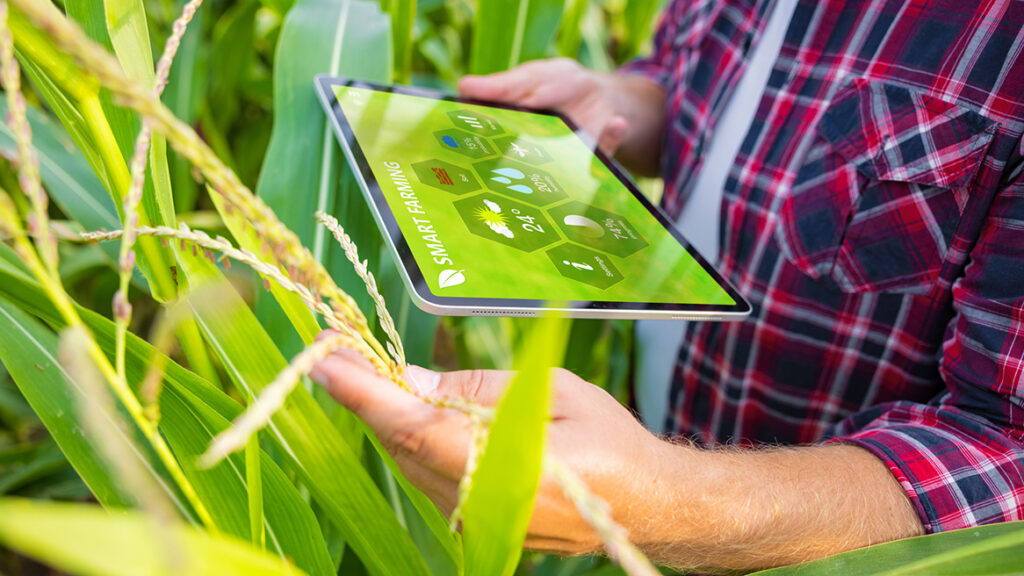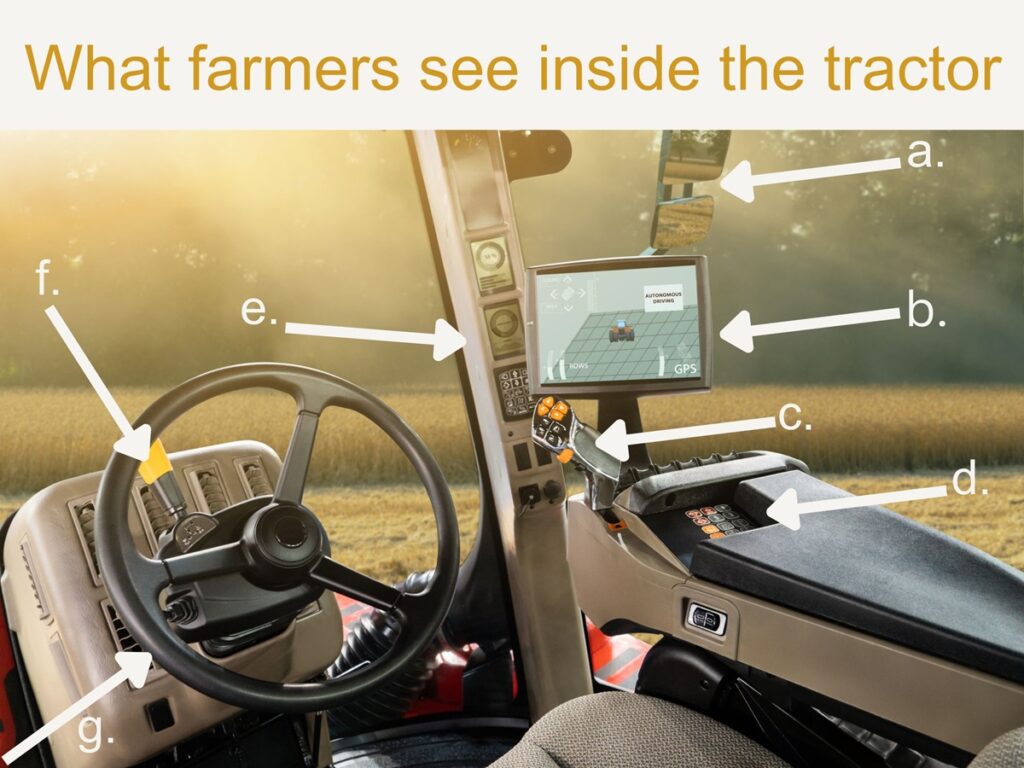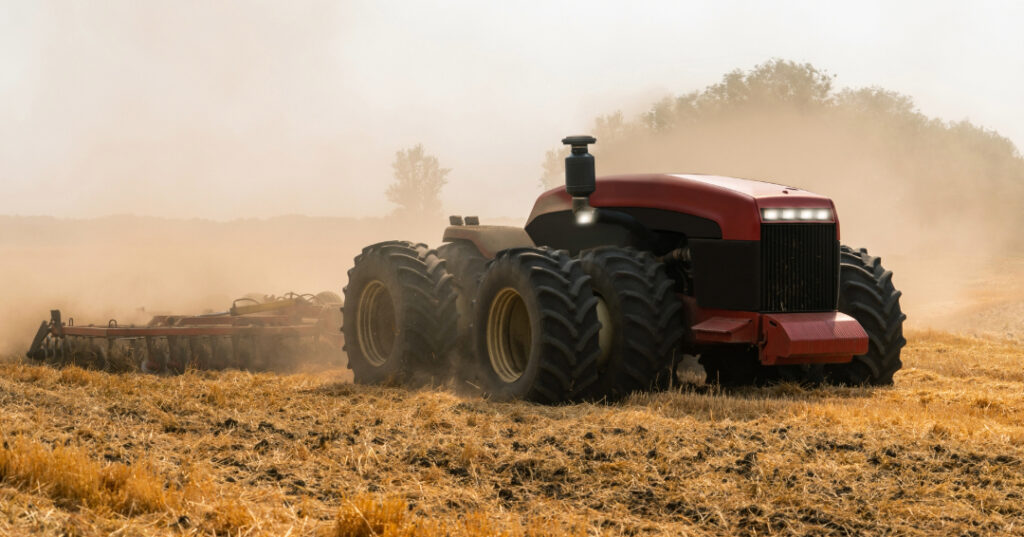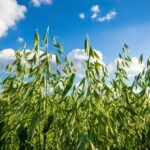Tech toolbox for sustainable farming

Into the classroom!
Advanced technology may seem at odds with students’ ideas of farming. But today’s farmers are working smarter and using technology to apply sustainable farming practices.
In this blog we will provide:
- Ideas for introducing students to technology in agriculture
- How farmers use technology for sustainable farming
- Tools for teachers: STEM challenge, vocabulary, videos and activities!
Check out pages 20 – 21 of the Real Dirt on Farming (Chapter 3) for a quick look at the ways technology supports sustainable farming.
Talking with students about how farmers use technology to farm sustainably
Starting with a visual may be useful. We know most students are unfamiliar with modern farms—this might get their attention! Feel free to copy these images into your teaching slides.

Technology is helping farmers be more productive and protect the environment.
Technology is everywhere in our lives! Brainstorm: How many technological things can students name that make their lives easier or more efficient?
Farms are definitely not like they used to be! Modern farms have lots of technology—think robots, drones, mapping, GPS. It all helps farmers work smarter and farm sustainably. Here’s an example:
A farmer needs to know what is happening on a part of the farm far from the house. At the same time, the farmer needs to order supplies and program the GPS on the tractor. They can send a drone to observe and record the field conditions and it will send a report to a tablet or smartphone. That saves the time and fuel it would take to drive to that part of the farm and back. It also avoids compacting the soil caused by driving over fields.
Discuss: Let’s think about what farmers can do better using technology! What kind of technology do they use? How does it help them farm sustainably to protect the environment?
- The Internet of Things (IoT): We all use the Internet of Things! It is all the things and devices that use technology to connect to other things and devices. We call them “smart” things—yes, like a smartphone or smartwatch! Farmers use the Internet of Things every day to do their work. Some things they use are:
- Sensors measure moisture, temperature, and nutrients in the soil. This helps the soil from using too much fertilizer or water. Too much fertilizer can be unhealthy to growing plants and too much water can cause the soil to be washed away.
- Sensors measure moisture or gases in grain bins where harvested grain is stored. It keeps our grains safe, in good quality for food use, and prevents on farm waste.
- Drones with cameras and sensors can take special types of pictures to show signs of pests, diseases, or not enough nutrients above a field. The information helps the farmer spray just the right amounts of pest control, disease treatment, and fertilizer.
- Smart imaging on sprayers can tell the difference between crop plants and weeds, and apply herbicide only on the weeds, not the whole crop.
- Satellites: farmers don’t have their own satellites but satellite images help them see things they can’t see easily with their eyes, such as temperature, moisture and drainage, ground movement and surface changes, insect infestations, and plant health.
- GPS: Farmers use GPS (global positing systems) to guide tractors and other equipment. GPS is very precise, so machines don’t overlap rows, space rows too far apart, or turn too wide. This helps the farmer saves fuel and emissions, protectes the soil form unnecessary vehicle movement and saves on over or under applying seeds, fertilizers or pest control products.
- Robots: Robots will soon have a place on grain farms. Researchers are working on ways for robots to do tasks such as, sampling and testing soil, spreading fertilizer only where it is needed, weeding, and preparing soil for planting.
Farms are on the front line of using renewable energy (solar and wind)
Many Canadian farms produce renewable energy and from 2016 to 2021, the number producing their own renewable energy more than doubled. That means such farms not only have clean energy, but they can sell their excess to the grid.
Many Ontario farmers use ethanol or biofuel instead of regular diesel fuel. Ethanol is fuel made by distilling grain to create ethyl alcohol, which can be blended with gasoline. Ethanol is considered renewable because it is made from biomass and produces fewer emissions than gasoline or diesel. Most ethanol in Canada and the United States is made from grain corn or wheat and biodiesel is made from soybean oil (usually used cooking oil).
Farm equipment is a STEM playground!
Tractors, planters, sprayers, combine harvesters,—they all work with precision because of GPS, mapping, sensors, or imaging.
- Tractors have always been used to pull anything and everything on the farm. In the past, they had an engine, four wheels—two big, two small—a seat, and a steering wheel. Today’s tractors have all those things and much more! Some even drive themselves! GPS helps tractors drive in precise, straight rows, which helps other machines do their jobs by following the straight lines. If you’ve never been inside a tractor, this may help.


- Technology helps farmers apply the proper products (fertilizer, pesticides), in the right amounts. The farmer can map the farm with a drone to identify areas that need attention and then transfer the digital map to the tractor and sprayer. When the farmer takes the sprayer into the field, the sprayer automatically turns on and off in different sections of the field. This allows the farmer to apply only what is needed, exactly where it is needed throughout the field. The precision means the entire field is not sprayed. The on-off spraying is called variable rate application.
Let’s Discuss!
Here are some questions to help students reflect on the lesson and kick off ideas. Feel free to copy and paste them into an assignment or your slides!
- How much of the technology used on farms is the same as, or similar to, the technology you use in your life?
- Technology is helping farmers be more precise in their work. How does that help them farm sustainably? (Hint: think about what you know about protecting the soil and water.)
- What other technology do you think can work on farms? How? (Hint: think about forms of technology you have heard of, such as 3-D printing, artificial intelligence, virtual reality.)
- What types of high-tech farm equipment do you think will be used on farms in the future?
STEM Challenge: Soil Runoff
When we talk about farming, we talk a lot about soil. Do you think that’s because soil is the most important part of farming?
One risk to soil is erosion from water, which can come from overwatering, snow melting too quickly, or heavy rain. Too much water can wash good soil away from the field, leaving only soil with few nutrients for plants.
Your challenge: design a system for holding soil in place when there is too much water.
Remember to:
- Think carefully about the problem. (When it happens, will a farmer know right away?)
- Use the engineering design process to design your system
- Explain how your system supports sustainability.
- Evaluate your work:
- Was your design successful?
- How could you improve your design?
Vocabulary/Word Wall
- Biofuel: a fuel made from living plant matter
- Drone: also known as an unmanned aerial vehicle (UAV); an aircraft without a human pilot or passengers
- Ethanol: a colorless flammable liquid that we can make by fermenting a plant’s sugars, typically grain corn.
- Internet of Things: the connection (through the Internet) of devices in everyday objects that allows them to send and receive data
- Phenotyping: the activity of analyzing an organism’s phenotype, especially its DNA. The phenotype is the characteristics we can see in an individual living thing that comes from the it interacting with the environment
- Satellite: an artificial object that is put in orbit around Earth or the moon or another planet to communicate or to collect information
- Sensor: a device that measures something specific and responds to it by reporting or acting on the information
- Technology: using scientific knowledge to do things; also, the machines or equipment created by using scientific knowledge
Tools for teaching!
A collection of videos and activities to help students understand grain farming and sustainability!
For Teachers (to help you teach unfamiliar topics!)
Supplement your knowledge with the Real Dirt on Farming (Chapter 3) and its Educator Guide.
Reminder: Last month we talked about sustainability practices on the farm.
Activities
Tractors…. in space!
This activity is part of the art-based Draw with Rob series of draw-along videos with children’s author and illustrator Rob Biddulph. It includes a free educator resource, a bonus activity, and a teacher resource about tractors and their many uses. You may wish to use Activity 8: Future farm machines as a STEM challenge.
Activities include:
- Basic shapes
- Negative space
- Prints and impressions
- Satellite’s view
- Pixel art
- Unplugged coding
- Future farm machines

Videos
Drones Finding Weeds
Drones use thermal imaging to tell the difference between a weed and a crop plant.
Autonomy Project: Harvesting System
An example of precision agriculture. As the video plays, ask students whether they notice anything unusual about the tractor pulling the blue wagon as it works with the combine. Note that it has no driver and is operated using autonomous (robot) and GPS technology. It allows the farmer to work more efficiently-a single person can harvest an entire field.
Precision Variable Rate Application: Irrigation
The system allows the farmer to program irrigation to a certain depth, saving water and preventing over-watering. It gives the farmer the control to avoid watering roads, waterways, and unproductive land. The farmer can make the most of water and fertilizer and protect areas that are environmentally sensitive. The system can even be remote-controlled.
Exhibit
Space to Spoon
What does a satellite orbiting 798 km from Earth have to do with the food on our plate? From the Canada Agriculture and Food Museum, a travelling exhibit that demonstrates how Space technology benefits Canadian farmers and sustainable agriculture.
Final opportunity to see it: Feb 8 – May 20, 2024
Full details: https://ingeniumcanada.org/agriculture/exhibitions/space-to-spoon-travelling
Curriculum Connections
Grade 3:
| STEM Skills and Connections |
| A1. STEM Investigation and Communication Skills Use an engineering design process to conduct investigations. |
| A3. Applications, Connections, and Contributions A3.1 describe practical applications of science and technology concepts in their home and community, and how these applications address real-world problems |
| A3.2 investigate how science and technology can be used with other subject areas to address real-world problems |
| E. Earth and Space Systems Soils in the Environment |
| E1.2 assess the impact of human activity on soils, and describe ways in which humans can improve the quality of soils and/or lessen or prevent harmful effects on soils |
| E2.1identify the living and non-living components of soil, and describe the characteristics of healthy soil |
| E2.2 identify different substances that are commonly added to, or absorbed by, the soil, and describe their effects on soil health |
| E2.4 explain the process of erosion, including its causes and its impact on soils |
| E2.5 identify various strategies used to maintain and improve soil health in Ontario |



